
How to Use Soil moisture: Examples, Pinouts, and Specs
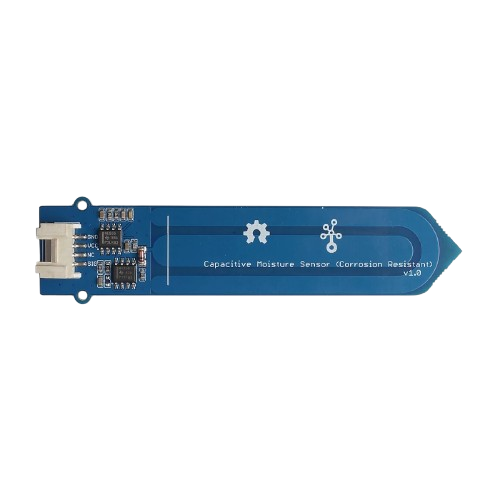
 Design with Soil moisture in Cirkit Designer
Design with Soil moisture in Cirkit DesignerIntroduction
The Soil Moisture Sensor is an electronic device designed to measure the volumetric water content in soil. It provides an analog or digital output that corresponds to the moisture level, making it an essential tool for applications such as automated irrigation systems, agricultural monitoring, and gardening projects. By integrating this sensor into a system, users can optimize water usage and ensure plants receive the appropriate amount of hydration.
Explore Projects Built with Soil moisture
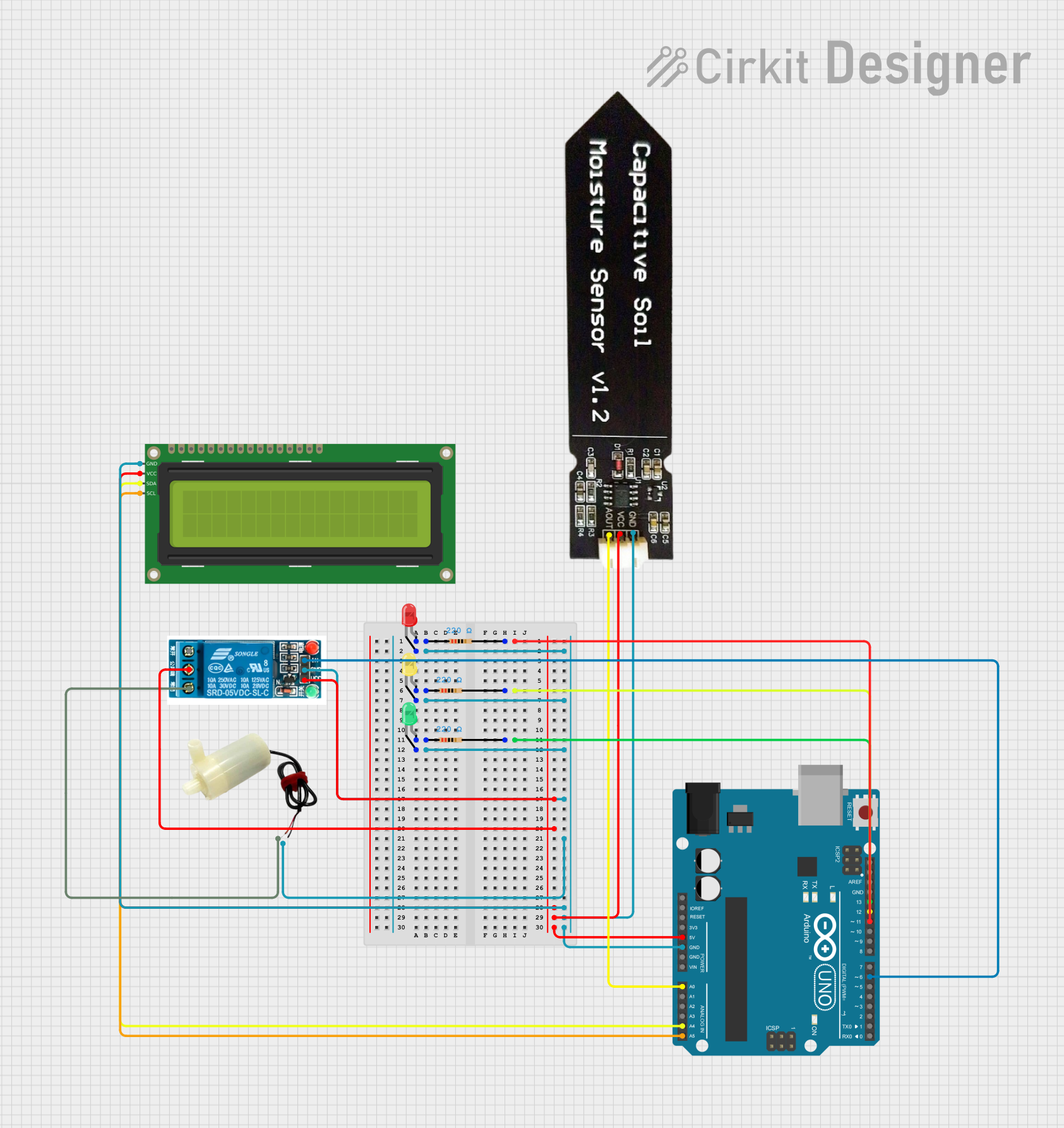
 Open Project in Cirkit Designer
Open Project in Cirkit Designer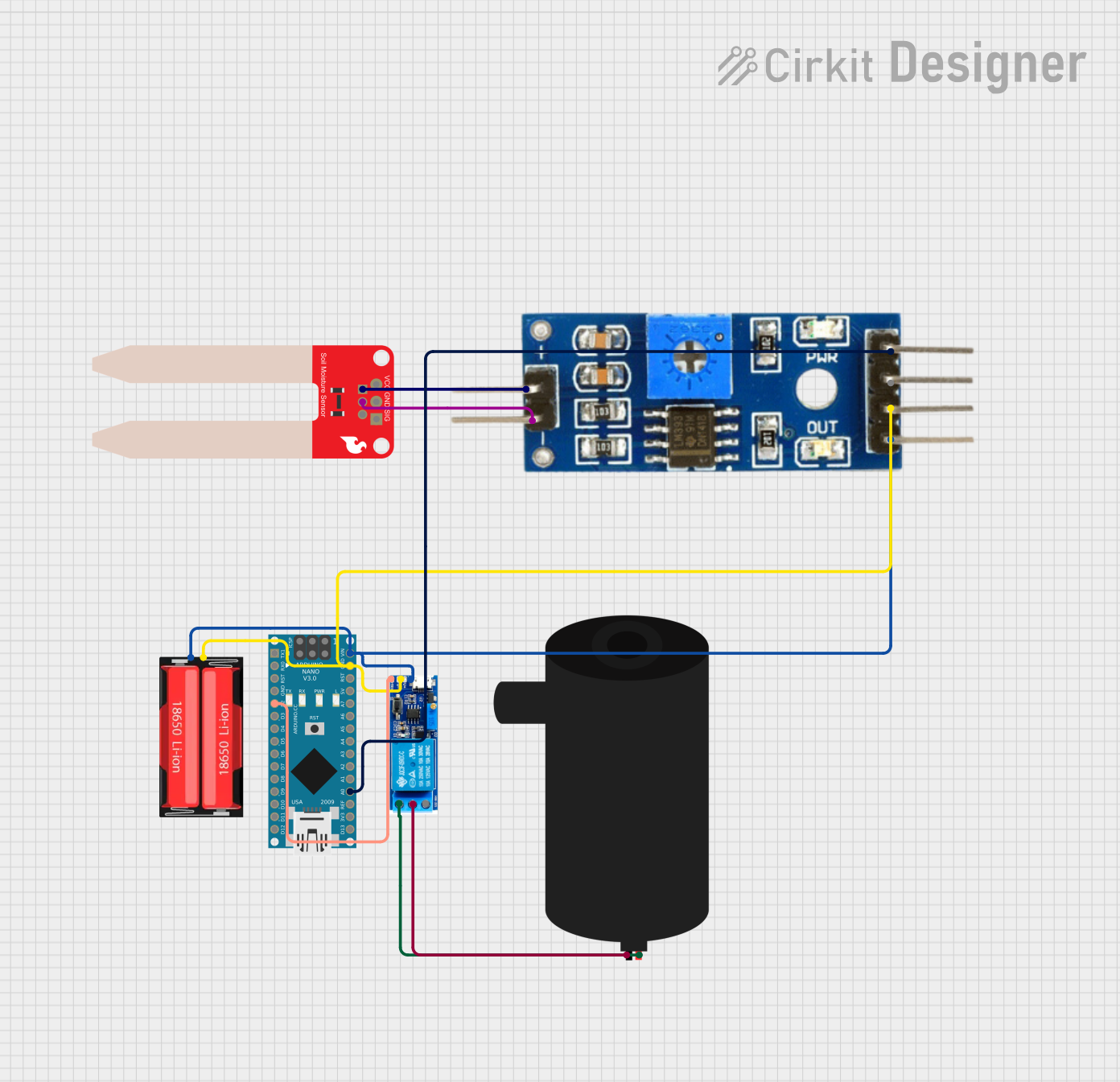
 Open Project in Cirkit Designer
Open Project in Cirkit Designer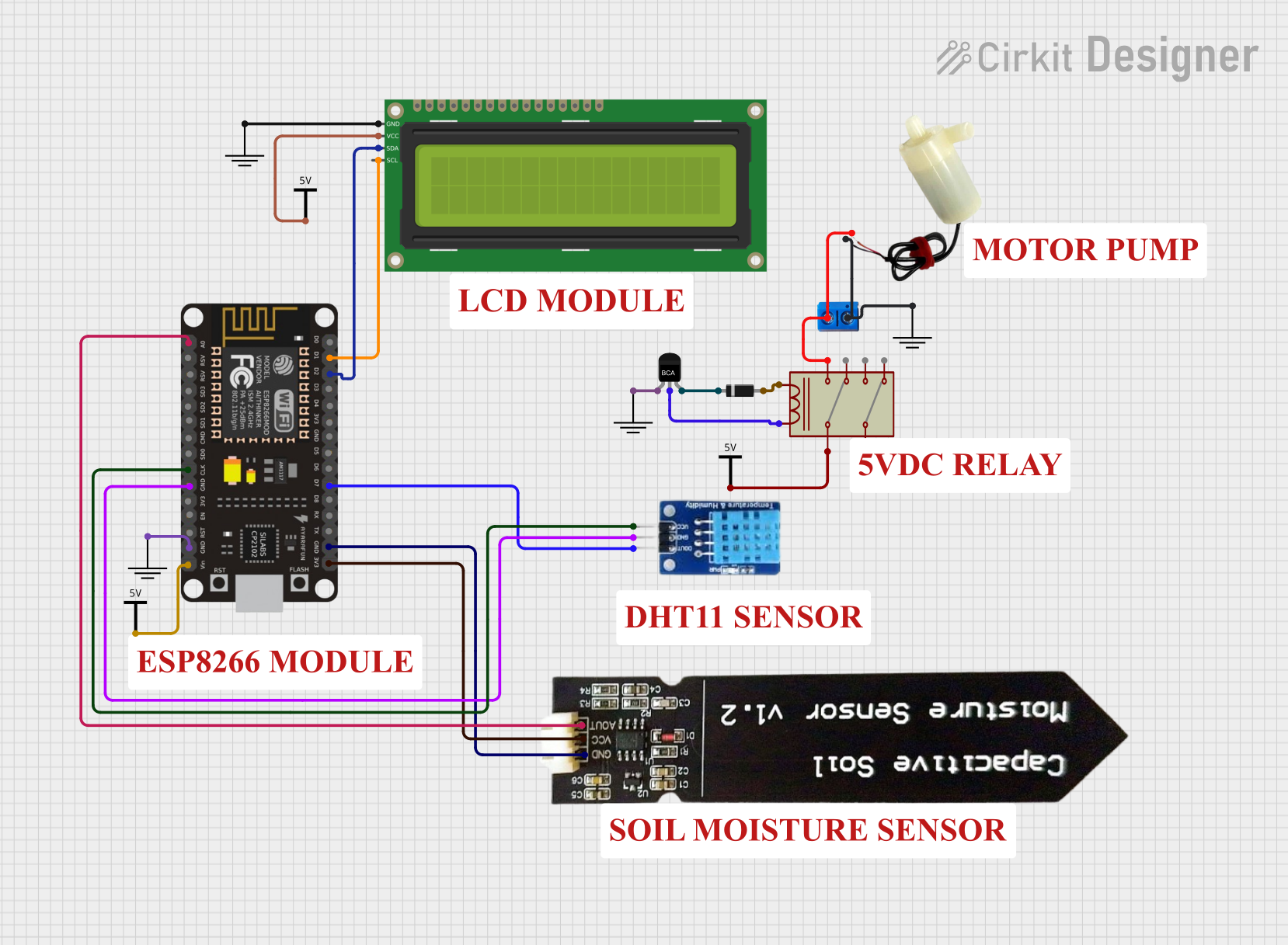
 Open Project in Cirkit Designer
Open Project in Cirkit Designer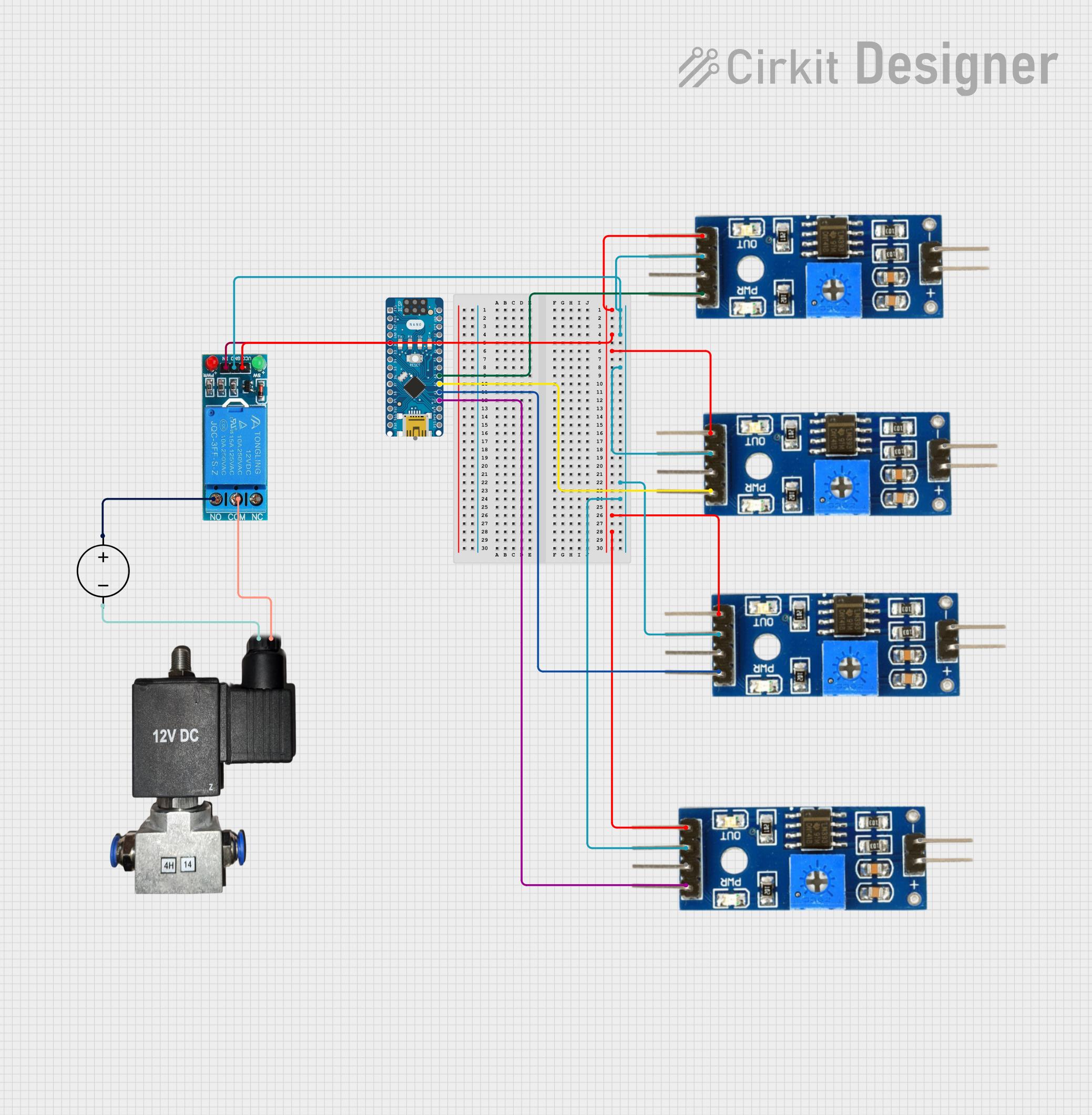
 Open Project in Cirkit Designer
Open Project in Cirkit DesignerExplore Projects Built with Soil moisture

 Open Project in Cirkit Designer
Open Project in Cirkit Designer
 Open Project in Cirkit Designer
Open Project in Cirkit Designer
 Open Project in Cirkit Designer
Open Project in Cirkit Designer
 Open Project in Cirkit Designer
Open Project in Cirkit DesignerCommon Applications and Use Cases
- Automated irrigation systems for agriculture and gardening
- Soil monitoring in greenhouses
- Smart gardening projects
- Environmental monitoring systems
- Educational projects involving soil and plant science
Technical Specifications
The Soil Moisture Sensor typically consists of two probes that measure the resistance of the soil, which varies with moisture content. Below are the key technical details:
| Parameter | Specification |
|---|---|
| Operating Voltage | 3.3V - 5V |
| Output Type | Analog (voltage) and Digital (HIGH/LOW) |
| Current Consumption | < 20mA |
| Operating Temperature | -10°C to 60°C |
| Dimensions | ~60mm x 20mm |
| Probe Material | Corrosion-resistant metal |
Pin Configuration and Descriptions
The sensor module typically has the following pins:
| Pin Name | Description |
|---|---|
| VCC | Power supply pin (3.3V - 5V) |
| GND | Ground pin |
| A0 | Analog output pin, provides a voltage proportional to soil moisture |
| D0 | Digital output pin, outputs HIGH or LOW based on a user-defined threshold |
Usage Instructions
How to Use the Sensor in a Circuit
Connect the Sensor to a Microcontroller:
- Connect the
VCCpin to the 5V pin of the microcontroller (e.g., Arduino UNO). - Connect the
GNDpin to the ground (GND) of the microcontroller. - Connect the
A0pin to an analog input pin (e.g., A0 on Arduino UNO) for continuous moisture readings. - Optionally, connect the
D0pin to a digital input pin if you want to use the threshold-based digital output.
- Connect the
Insert the Probes into the Soil:
- Place the sensor probes into the soil at the desired depth. Ensure the probes are fully in contact with the soil for accurate readings.
Calibrate the Sensor:
- Use the potentiometer on the sensor module to adjust the threshold for the digital output (D0). Turn the screw clockwise or counterclockwise to set the desired moisture level.
Read the Output:
- For analog readings, use the
A0pin to measure the voltage, which corresponds to the soil moisture level. - For digital readings, monitor the
D0pin to check if the soil moisture is above or below the threshold.
- For analog readings, use the
Important Considerations and Best Practices
- Avoid prolonged exposure of the sensor to water, as it may cause corrosion over time.
- Use the sensor in well-drained soil to prevent waterlogging, which can damage the probes.
- For long-term use, consider sealing the connections with waterproof materials to prevent short circuits.
- Periodically clean the probes to remove dirt or debris that may affect accuracy.
Example Code for Arduino UNO
The following code demonstrates how to use the Soil Moisture Sensor with an Arduino UNO to read analog values and display them in the Serial Monitor.
// Define the analog pin connected to the sensor's A0 pin
const int soilMoisturePin = A0;
// Variable to store the sensor reading
int soilMoistureValue;
void setup() {
// Initialize the Serial Monitor for debugging
Serial.begin(9600);
}
void loop() {
// Read the analog value from the sensor
soilMoistureValue = analogRead(soilMoisturePin);
// Print the sensor value to the Serial Monitor
Serial.print("Soil Moisture Value: ");
Serial.println(soilMoistureValue);
// Add a small delay to avoid flooding the Serial Monitor
delay(1000);
}
Interpreting the Output
- The analog value ranges from 0 to 1023 (for a 10-bit ADC on Arduino UNO).
- A lower value indicates higher moisture content, while a higher value indicates drier soil.
Troubleshooting and FAQs
Common Issues and Solutions
No Output or Incorrect Readings:
- Ensure the sensor is properly connected to the microcontroller.
- Verify that the power supply voltage is within the specified range (3.3V - 5V).
- Check for loose or corroded connections.
Inconsistent Readings:
- Clean the sensor probes to remove dirt or debris.
- Ensure the sensor is inserted into the soil properly and is not loose.
Sensor Corrosion:
- Avoid leaving the sensor in wet soil for extended periods.
- Use a corrosion-resistant version of the sensor for long-term projects.
Digital Output Not Triggering:
- Adjust the potentiometer to set the correct threshold for the digital output.
- Verify that the
D0pin is connected to a digital input pin on the microcontroller.
FAQs
Q: Can the sensor be used in hydroponic systems?
A: The sensor is designed for soil-based applications. For hydroponics, consider using a water-level or EC (electrical conductivity) sensor.
Q: How deep should the sensor be inserted into the soil?
A: Insert the sensor probes to the depth where you want to measure moisture, typically 2-3 inches for most plants.
Q: Can I use multiple sensors in one project?
A: Yes, you can connect multiple sensors to different analog or digital pins on the microcontroller.
Q: How do I protect the sensor from environmental damage?
A: Use waterproofing materials for the connections and avoid prolonged exposure to waterlogged soil.